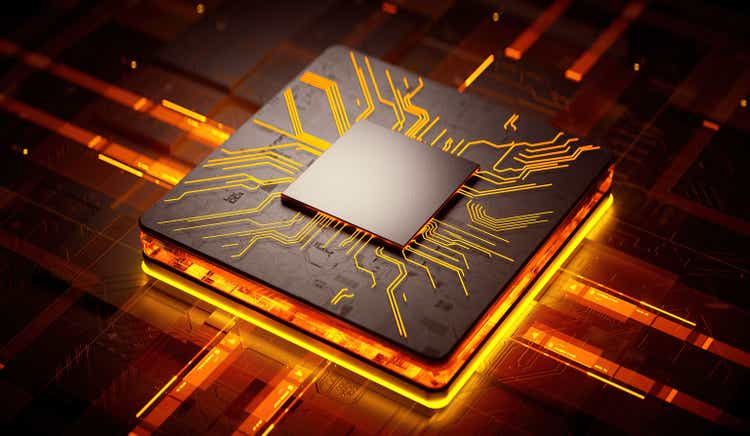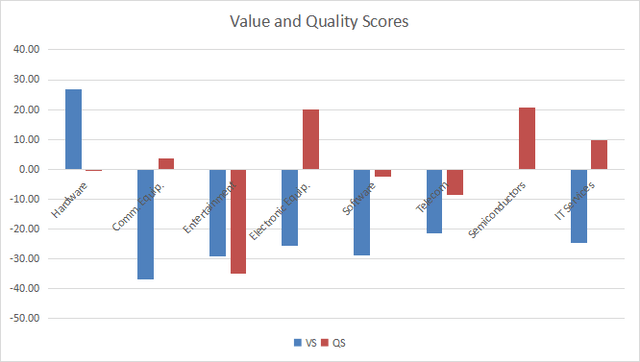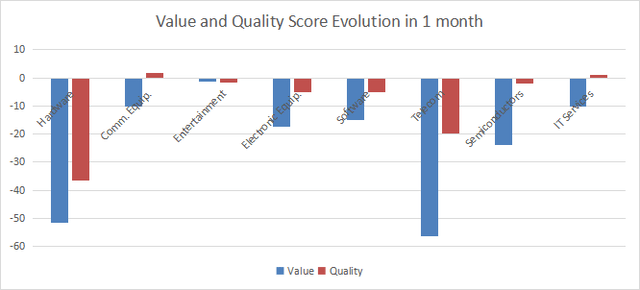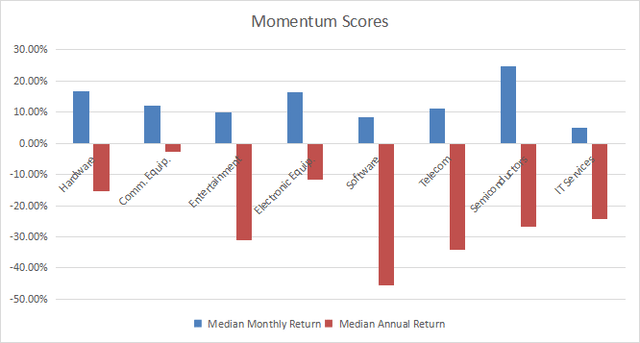jiefeng jiang
This monthly article series shows a dashboard with aggregate industry metrics in technology and communication services. It may also serve as a top-down analysis of technology ETFs like the Fidelity MSCI Information Technology Index ETF (NYSEARCA:FTEC), whose largest holdings are used to calculate these metrics.
Shortcut
The next two paragraphs in italic describe the dashboard methodology. They are necessary for new readers to understand the metrics. If you are used to this series or if you are short of time, you can skip them and go to the charts.
Base Metrics
I calculate the median value of five fundamental ratios for each industry: Earnings Yield (“EY”), Sales Yield (“SY”), Free Cash Flow Yield (“FY”), Return on Equity (“ROE”), Gross Margin (“GM”). The reference universe includes large companies in the U.S. stock market. The five base metrics are calculated on trailing 12 months. For all of them, higher is better. EY, SY and FY are medians of the inverse of Price/Earnings, Price/Sales and Price/Free Cash Flow. They are better for statistical studies than price-to-something ratios, which are unusable or non available when the “something” is close to zero or negative (for example, companies with negative earnings). I also look at two momentum metrics for each group: the median monthly return (RetM) and the median annual return (RetY).
I prefer medians to averages because a median splits a set in a good half and a bad half. A capital-weighted average is skewed by extreme values and the largest companies. My metrics are designed for stock-picking rather than index investing.
Value and Quality Scores
I calculate historical baselines for all metrics. They are noted respectively EYh, SYh, FYh, ROEh, GMh, and they are calculated as the averages on a look-back period of 11 years. For example, the value of EYh for hardware in the table below is the 11-year average of the median Earnings Yield in hardware companies.
The Value Score (“VS”) is defined as the average difference in % between the three valuation ratios (EY, SY, FY) and their baselines (EYh, SYh, FYh). The same way, the Quality Score (“QS”) is the average difference between the two quality ratios (ROE, GM) and their baselines (ROEh, GMh).
The scores are in percentage points. VS may be interpreted as the percentage of undervaluation or overvaluation relative to the baseline (positive is good, negative is bad). This interpretation must be taken with caution: the baseline is an arbitrary reference, not a supposed fair value. The formula assumes that the three valuation metrics are of equal importance.
Current data
The next table shows the metrics and scores as of last week’s closing. Columns stand for all the data named and defined above.
|
VS |
QS |
EY |
SY |
FY |
ROE |
GM |
EYh |
SYh |
FYh |
ROEh |
GMh |
RetM |
RetY |
|
|
Hardware |
26.85 |
-0.51 |
0.0649 |
1.3399 |
0.0238 |
7.81 |
38.69 |
0.0363 |
0.9351 |
0.0407 |
7.35 |
41.77 |
16.76% |
-15.32% |
|
Comm. Equip. |
-36.84 |
3.74 |
0.0285 |
0.1837 |
0.0135 |
18.97 |
55.21 |
0.0314 |
0.2785 |
0.0412 |
15.70 |
63.72 |
12.23% |
-2.68% |
|
Entertainment |
-29.31 |
-35.01 |
0.0138 |
0.6452 |
0.0146 |
6.42 |
41.99 |
0.0492 |
0.4428 |
0.0381 |
17.20 |
45.32 |
10.03% |
-31.16% |
|
Electronic Equip. |
-25.57 |
20.05 |
0.0396 |
0.5996 |
0.0231 |
17.04 |
38.68 |
0.0433 |
0.8108 |
0.0399 |
12.96 |
35.61 |
16.48% |
-11.59% |
|
Software |
-28.88 |
-2.59 |
0.0209 |
0.1192 |
0.0252 |
17.45 |
82.84 |
0.0270 |
0.1743 |
0.0373 |
17.71 |
86.05 |
8.45% |
-45.51% |
|
Telecom |
-21.40 |
-8.67 |
0.0358 |
0.8425 |
0.0095 |
10.06 |
57.14 |
0.0502 |
0.6516 |
0.0270 |
11.81 |
58.61 |
11.23% |
-34.08% |
|
Semiconductors |
-0.36 |
20.73 |
0.0557 |
0.2228 |
0.0320 |
33.34 |
62.67 |
0.0467 |
0.2482 |
0.0356 |
23.69 |
62.22 |
24.89% |
-26.71% |
|
IT Services |
-24.75 |
9.81 |
0.0344 |
0.2182 |
0.0235 |
33.04 |
50.26 |
0.0387 |
0.3313 |
0.0331 |
25.61 |
55.48 |
5.00% |
-24.40% |
Value And Quality chart
The next chart plots the Value and Quality Scores by industry (higher is better).
Value and quality in technology (Chart: author; data: Portfolio123)
Evolution since last month
The value and quality scores fell sharply in hardware and telecommunication.
Variations in value and quality (Chart: author; data: Portfolio123)
Momentum
The next chart plots momentum data.
Momentum in technology (Chart: author; data: Portfolio123)
Interpretation
Hardware is undervalued by about 27% relative to 11-year averages, and it is close to its quality baseline. Semiconductors are close to the baseline in value and above it in quality. Other industries are overvalued by 21% to 37% regarding the same metrics. Good quality scores may partly justify overvaluation in IT services and electronic equipment.
Focus on FTEC
The Fidelity MSCI Information Technology Index ETF has been tracking the MSCI USA IMI Information Technology 25/50 Index since 10/21/2013. It has a total expense ratio of 0.08%, which is a bit cheaper than other passive index ETFs in the same sector like Communication Services Select Sector SPDR Fund (XLK) and Vanguard Information Technology ETF (VGT) (0.10%). As of writing, the fund holds 381 stocks. The next table shows the top 10 holdings with basic valuation and growth metrics. Their aggregate weight is 59.1%. The top two holdings (Apple Inc and Microsoft Corp) weigh 40.2% together, which represents a high exposure to risks related to these companies.
|
Ticker |
Name |
Weight% |
EPS growth %TTM |
P/E TTM |
P/E fwd |
Yield% |
|
Apple, Inc. |
23.25 |
8.83 |
24.59 |
24.09 |
0.61 |
|
|
Microsoft Corp. |
16.95 |
3.73 |
26.07 |
25.43 |
1.12 |
|
|
Visa, Inc. |
3.52 |
25.45 |
30.50 |
25.29 |
0.86 |
|
|
NVIDIA Corp. |
3.48 |
8.85 |
54.66 |
49.86 |
0.10 |
|
|
Mastercard, Inc. |
2.93 |
23.12 |
34.31 |
32.59 |
0.57 |
|
|
Broadcom, Inc. |
1.97 |
70.17 |
22.85 |
13.97 |
3.13 |
|
|
Cisco Systems, Inc. |
1.94 |
12.84 |
15.92 |
12.74 |
3.39 |
|
|
Accenture PLC |
1.85 |
17.01 |
27.32 |
25.65 |
1.53 |
|
|
Salesforce, Inc. |
1.67 |
-78.58 |
302.93 |
34.22 |
0 |
|
|
Adobe, Inc. |
1.55 |
-16.14 |
34.10 |
25.39 |
0 |
Data calculated with Portfolio123.
Since inception in October 2013, FTEC has slightly underperformed XLK, but the difference annualized return and risk metrics is insignificant.
|
Total Return |
Annual. Return |
Drawdown |
Sharpe |
Volatility |
|
|
FTEC |
345.96% |
17.96% |
-36.82% |
0.91 |
19.00% |
|
XLK |
352.73% |
18.16% |
-35.48% |
0.94 |
18.32% |
FTEC is a fund with cheap fees for investors seeking a capital-weighted exposure in technology. It holds much more stocks than XLK (currently 381 vs. 78), but past performance is very close to it. Investors willing to keep a position in technology for the long-term may indifferently choose FTEC or XLK. Liquidity makes XLK a better choice for tactical allocation and trading. For those who want to limit exposure to Apple and Microsoft, the Invesco S&P 500 Equal Weight Technology ETF (RYT) is a better choice.
Dashboard List
I use the first table to calculate value and quality scores. It may also be used in a stock-picking process to check how companies stand among their peers. For example, the EY column tells us that a hardware company with an earnings yield above 0.0649 (or price/earnings below 15.41) is in the better half of the industry regarding this metric. A Dashboard List is sent every month to Quantitative Risk & Value subscribers with the most profitable companies standing in the better half among their peers regarding the three valuation metrics at the same time. The list below was sent to subscribers several weeks ago based on data available at this time.
|
Alpha & Omega Semiconductor Ltd. |
|
|
Kulicke & Soffa Industries, Inc. |
|
|
Thryv Holdings, Inc. |
|
|
Ziff Davis, Inc. |
|
|
Skyworks Solutions, Inc. |
|
|
Diodes, Inc. |
It is a rotating list with a statistical bias toward excess returns on the long-term, not the result of an analysis of each stock.


Be the first to comment